China Manufacturing – What’s Next After Xi Jinping’s CPC Reforms? – Analysis
A complete restructuring of China’s SOEs and Private Sector can be expected to meet the CPC targets with new hybrid models being introduced as unique economic structural solutions
The recent CPC Congress has laid out specific plans for restructuring China’s national manufacturing base in ways that have not been acknowledged by Western based analysts. In huge-scale modernization largely seen as unprecedented, a key task for the CPC outlined by Xi Jinping in his report to the 20th CPC National Congress was couched in terms such as “China will move forward on its own pathway to modernization” and “A vision for advancing the rejuvenation of the Chinese nation through a Chinese path to modernization.”
One of the defining features of this modernization, Xi said, is the modernization of a huge population, a number larger than the combined population of all developed countries in the world, stating “This is a task of unparalleled difficulty and complexity; it inevitably means that our pathways of development and methods of advancement will be unique.”
Within these somewhat bland terms however, lies the construction of a new China manufacturing and trade base and a massive period of reform. This has very specific implications for how China intends to both lift another 400 million Chinese to middle-class income standards, and continue its drive to develop its exports, issues I discussed here.
China’s Demographic Headwinds

There are Chinese domestic headwinds to contend with. China’s latest national census data, published in May 2021, showed a fertility rate of just 1.3 children per woman in 2020, which is on a par with aging societies like Japan. Over 18.9 percent of China’s population were age 60 or older by the end of 2021, according to the National Bureau of Statistics. Yet at the same time, the CPC has put in place an agenda to promote common prosperity for all, a drive that will entail further growth in income and public living standards for a large population while also maintaining its exports drive.
These two diverse acts require reforms to be put in place to enable the latter to develop at such a place it can absorb the demographic problems. It means that China, with its huge population, faces restrictions related to its resources and environment during its modernization process, which also means that the nation cannot blindly copy the model of modernization from other nations. This implies continuing divergence away from the Western, capitalist model and towards the development of a unique Chinese methodology concerning structural redevelopment. If Beijing gets this right, this will represent an immense change in the global landscape.
Yet how will this be achieved? What are the implications for foreign investors? There are some pointers.
Complete China Sectoral Restructuring

Xi stated that China must give priority to the development of all sectors, with greater emphasis given to the growth of the manufacturing and services industries. We already know that the manufacturing sector is the core pillar of the Chinese economy, while services is the area with the largest potential for growth. A systemic upgrading of the education system would be required for the further development of modern services, which could account for 25% of the Chinese economy by the current CPC’s analytical reach by 2035. That means opportunities in scientific and vocational training – which the United States is doing is best to curtail by standing in the way of Chinese students studying in specific sectors and in scientific research. However, it may pave the way for relations to be developed within China directly instead. We may see an uptick in research and industrial processing educational facilities related to existing Sino-Foreign JV’s in China – the emergence of educational colleges and their motivation by Beijing as part of a widened available scope of business activity could be introduced to facilitate this.
It may also pave the way for a structural re-alignment of China’s SOEs with the larger Chinese Private Sector companies, and merge to form a hybrid SOE-Private Equity business model. These would be ideal for housing very specific industrial educational facilities with research and experience and testing available on site. Such a merger also reins in some of the wilder excesses of some of the Chinese private sector (think: Jack Ma) while lessening some elements, but not all, of state control. This produces managerial problems as is apparent in the West, where political thinking has begun to intrude rather too far into corporate behavior – as we have seen with the withdrawal of Western businesses from the Russian market. If China can find a balance between its political business and its economic business and have them operate in tandem, this would be a significant move. It also prevents the duplication of capital assets and time in eliminating unnecessary competition as competing products would merely be honed into one encompassing the strengths of both and the weaknesses of either.
Continuing Rejection Of Western Capitalism

A key point of these hybrid ‘Private Sector SOEs’ is that social contributions would be very much part of their remit. The hand of Government would ensure fair and even play, as opposed to leaving the definition of that in the hands of shareholders. The fact that Shell plc, a public listed company in London, Amsterdam and New York have stated record profits of US$9.5 billion over the past 3 months, to be distributed among its shareholders rather than the British public, whose energy bills have shot up during the same period is an example of a situation that would not be permitted in China.
This shows that the paths being taken by China are very different from those being taken by the West. China has learnt to avoid the greed and cruelty that arose through the periods of the West’s Industrial Revolution. Beijing understands that trying to solve such shortages and maintaining ever-higher profit margins and dividends through a hegemonic, capitalist- based model – Commercial Empires such as the United States has developed, are becoming less viable strategies in a new tech and still growingly populated world. More needs to be reinvested and given back. Hybrid Private Sector SOEs would seem to me to be an obvious route for China to take.
There are issues here for the West to learn from. At the Governmental and Institutional level, reining in the worst excesses of capitalism – such as Exxon’s Chief Executive being described by US President Joe Biden as “Earning more money than God” are inherently unstable and will bring – and are possibly already bringing, mass social unrest. China is proposing a fairer model which should not necessarily be looked at in the simple prism of democracy vs. socialism. It’s not very democratic when one entity hoovers up all the money.
Increasing Foreign Market Access To China

Concerning business, and foreign investment into China, Xi at the CPC also stated that the country would continue its program of development, reform and opening up. That means there will be more opportunities for foreign investors to participate in industry and service sectors that were previously the sole preserve of its SOEs with no foreign competition allowed. Yet today, international insurance and pension funds are starting to be allowed to operate in China – with Hong Kong soon to be the base for investors to obtain licenses and under the relevant regulations, market and sell wealth creation and security products to mainland Chinese nationals. That’s just one example, albeit one not actively covered in the media.
Another will be ‘Management Consulting with Chinese Characteristics” as China’s large SOEs and Private Sector businesses – some with foreign equity partners – are encouraged to merge. That also means new regulations can be expected to manage these, while more, not less foreign involvement in these businesses will also emerge. This will lead to more Sino-Foreign Joint Ventures in turn being created – with many having the Chinese as minority, yet influential partners on board.
Wealth Creation

This, I suspect, is what is meant when Xi stated at the CPC that there is a path to Chinese modernization yet with different characteristics than the West has followed. The politicians will continue to talk up China as a threat, mainly one suspects as it remains a non-Western democratic model, and the West’s may have either run its course or is in need of its own serious reform. But for foreign investors, these reforms also present an opportunity – to engage. Given that engagement with other parties is indeed a core feature of democracy, contemporary China and the path the CPC and Xi Jinping have set until 2035 is of extreme interest to those looking at where China is going, what it needs to get there, and what the goals are. Right now, much of that is centred around Wealth Creation. Surely someone from the West is interested in such a proposition?
Chris Devonshire-Ellis is the Chairman of Dezan Shira & Associates, and has a 30 year career in advising foreign investors in China. His firm has thirteen China offices and several hundred staff and also maintains a considerable presence throughout ASEAN, India, Russia and the Middle East. Contact: asia@dezshira.com or visit www.dezshira.com
Related Reading
 An Introduction to Doing Business in China 2022
An Introduction to Doing Business in China 2022




